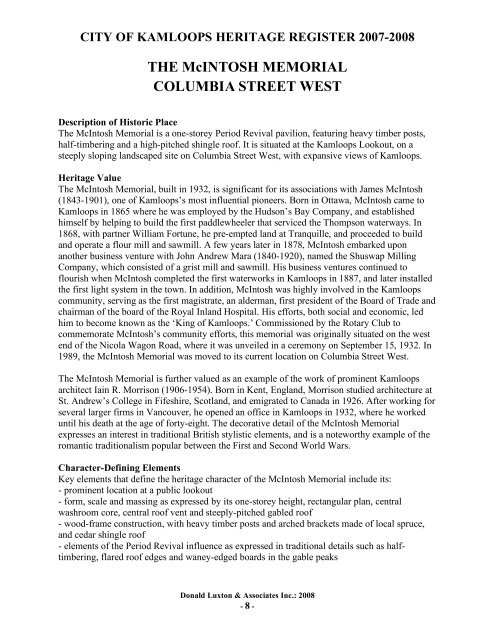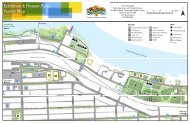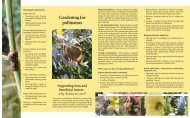Kamloops Heritage Register - City of Kamloops
Kamloops Heritage Register - City of Kamloops
Kamloops Heritage Register - City of Kamloops
Create successful ePaper yourself
Turn your PDF publications into a flip-book with our unique Google optimized e-Paper software.
CITY OF KAMLOOPS HERITAGE REGISTER 2007-2008<br />
THE McINTOSH MEMORIAL<br />
COLUMBIA STREET WEST<br />
Description <strong>of</strong> Historic Place<br />
The McIntosh Memorial is a one-storey Period Revival pavilion, featuring heavy timber posts,<br />
half-timbering and a high-pitched shingle ro<strong>of</strong>. It is situated at the <strong>Kamloops</strong> Lookout, on a<br />
steeply sloping landscaped site on Columbia Street West, with expansive views <strong>of</strong> <strong>Kamloops</strong>.<br />
<strong>Heritage</strong> Value<br />
The McIntosh Memorial, built in 1932, is significant for its associations with James McIntosh<br />
(1843-1901), one <strong>of</strong> <strong>Kamloops</strong>’s most influential pioneers. Born in Ottawa, McIntosh came to<br />
<strong>Kamloops</strong> in 1865 where he was employed by the Hudson’s Bay Company, and established<br />
himself by helping to build the first paddlewheeler that serviced the Thompson waterways. In<br />
1868, with partner William Fortune, he pre-empted land at Tranquille, and proceeded to build<br />
and operate a flour mill and sawmill. A few years later in 1878, McIntosh embarked upon<br />
another business venture with John Andrew Mara (1840-1920), named the Shuswap Milling<br />
Company, which consisted <strong>of</strong> a grist mill and sawmill. His business ventures continued to<br />
flourish when McIntosh completed the first waterworks in <strong>Kamloops</strong> in 1887, and later installed<br />
the first light system in the town. In addition, McIntosh was highly involved in the <strong>Kamloops</strong><br />
community, serving as the first magistrate, an alderman, first president <strong>of</strong> the Board <strong>of</strong> Trade and<br />
chairman <strong>of</strong> the board <strong>of</strong> the Royal Inland Hospital. His efforts, both social and economic, led<br />
him to become known as the ‘King <strong>of</strong> <strong>Kamloops</strong>.’ Commissioned by the Rotary Club to<br />
commemorate McIntosh’s community efforts, this memorial was originally situated on the west<br />
end <strong>of</strong> the Nicola Wagon Road, where it was unveiled in a ceremony on September 15, 1932. In<br />
1989, the McIntosh Memorial was moved to its current location on Columbia Street West.<br />
The McIntosh Memorial is further valued as an example <strong>of</strong> the work <strong>of</strong> prominent <strong>Kamloops</strong><br />
architect Iain R. Morrison (1906-1954). Born in Kent, England, Morrison studied architecture at<br />
St. Andrew’s College in Fifeshire, Scotland, and emigrated to Canada in 1926. After working for<br />
several larger firms in Vancouver, he opened an <strong>of</strong>fice in <strong>Kamloops</strong> in 1932, where he worked<br />
until his death at the age <strong>of</strong> forty-eight. The decorative detail <strong>of</strong> the McIntosh Memorial<br />
expresses an interest in traditional British stylistic elements, and is a noteworthy example <strong>of</strong> the<br />
romantic traditionalism popular between the First and Second World Wars.<br />
Character-Defining Elements<br />
Key elements that define the heritage character <strong>of</strong> the McIntosh Memorial include its:<br />
- prominent location at a public lookout<br />
- form, scale and massing as expressed by its one-storey height, rectangular plan, central<br />
washroom core, central ro<strong>of</strong> vent and steeply-pitched gabled ro<strong>of</strong><br />
- wood-frame construction, with heavy timber posts and arched brackets made <strong>of</strong> local spruce,<br />
and cedar shingle ro<strong>of</strong><br />
- elements <strong>of</strong> the Period Revival influence as expressed in traditional details such as halftimbering,<br />
flared ro<strong>of</strong> edges and waney-edged boards in the gable peaks<br />
Donald Luxton & Associates Inc.: 2008<br />
- 8 -

















